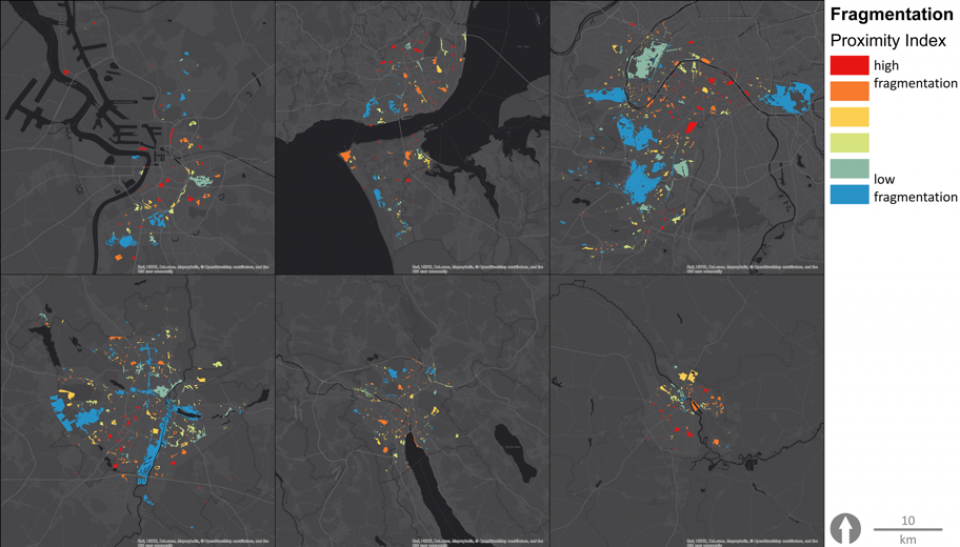
Zurich is the largest city in Switzerland with approx. 400,000 inhabitants. The city have a quite broad range of green and blue infrastructures with nice gradients of connectivity and fragmentation in more and less dense urbanized matrices, and very detailed digitalized land use maps exists. This work is part of a BiodivERsA project with case studies at the city-level in 7 countries – search for the “BIOVEINS” keyword to find out about the other case studies of the project in urban areas. Urban green areas have been shown to support native biodiversity, enhance ecosystem functions,and provide important ecosystem services (ESs), from improved air quality to habitat for nursery and gene flow. This is particularly true when trees are present. Moreover, urban green and blue infrastructures (GBI) contribute to human well-being. Nevertheless, urban areas are characterized by highly polluted air, and due to the high proportion of impervious surfaces, urban GBI are fragmented and isolated. The latter impacts both abiotic and biotic conditions: cities suffer from the urban heat island effect, while taxonomic and functional biodiversity tends to become more homogenous and residents are increasingly disconnected from nature itself. In this regard GBI enhance the permeability for both biodiversity and citizens through dense and hostile urban matrices.
The main objective of our BIOVEINS proposal is to use functional diversity (FD) to highlight the mechanisms underpinning the link between GBI, taxonomic diversity (TD) and ecosystem services (ESs) provisioning, and to provide, together with local stakeholders, the ecological and interdisciplinary knowledge to identify the critical features of GBI, to guide the establishment, management and restoration of GBI, and to mitigate the effects of major urban global challenges, like habitat fragmentation, air pollution, and urban heat island.
This main objective will be accomplished by several specific objectives: (i) to analyse, together with local stakeholders, the actual and planned GBI from an urban planning
perspective, determine representative sampling plots and derive prior actions based on specific
objectives (ii) – (iv); (ii) to assess the FD for a variety of taxonomic groups differing in dispersion ability, sensitivity to
environmental conditions and use of resources within GBI to link the considered taxa to ESs and to
determine the importance of GBI connectivity on urban biodiversity; (iii) to assess the impact of proportion, configuration and connectivity of urban GBI on provisioning and
regulating ESs by an experimental and modelling approach, and link these ESs to the data obtained in
(i-ii) to assess the role of TD and FD on these ESs; and (iv) to provide tools, best practices, and guidelines for the stakeholders about how to improve urban GBI and how to enhance multifunctional ESs for people and nature.
WP1 Selection of sampling sites Seven cities were selected in Europe with different types of urbanization and climate. GBI patches were selected in each city.
WP2 Biodiversity and ecosystem services’ indicators. 12 taxonomic groups will be investigated at each sampling site within the 7 cities: woody and flowering plants, lichens, leaf-dwelling bacteria, herbivorous mites, arthropods, birds and bats.
WP3: Regulating ES of WBI. Two main regulating ESs will be considered: air pollution mitigation and climate regulation. This will be assessed by combining vegetation traits with information of urban land cover and micro-climatic measurements.
WP4 Involving the power of citizen science. Two citizen science projects will be initiated in each city.
WP5 Stakeholder involvement. Stakeholders will be involved in developing guidelines for GBI best practice.
WP6 Result dissemination and communication. A website, blog, posters, artwork and data visualization will be used to bring urban biodiversity and GBI issues to the public.
Almost 80% of the population in developed countries lives in cities and a further increase is expected in the future. As a consequence a further loss of green spaces is anticipated, causing strong alterations of ecosystem processes and trophic interactions with exotic species playing an increasingly important role.
The project will provide a better understanding of the link between GBI distribution in cities and urban biodiversity and ecosystem services to cities. Through stakeholder engagement and outreach we will communicate these lessons and ideas to planners and residents of cities.
- Increase achievements of biodiversity targets
- Increase Biodiversity
- Increase quality and quantity of green and blue infrastructures
- Enhancing sustainable urbanisation
- Changing image of the urban environment
- Creation of green jobs relating to construction & maintenance of NBS
- Increase accessibility to green open spaces
- Increase amount of green open spaces for residents
- Increase awareness of NBS solution & their effectiveness and co benefits
- Increase population & infrastructures protected by NBS
- Increase stakeholder awareness & knowledge about NBS
- Increase well-being
- Increase willingness to invest in NBS
The project is still running (Jan. 2017 to Dec. 2019) and this page will be updated regularly as results, publications and reports are prepared.
This research was funded through the 2015-2016 BiodivERsA COFUND call for research proposals, with the national funders BelSPO (Belgium), FCT (Portugal), ANR (France) and ETAg (Estonia), NCN (Poland) and SNSF (Switzerland).
BIOVEINS Public outreach: Meredith Root-Bernstein, INRA, France mrootbernstein@gmail.com
BiodivERsA Science-policy/society interfacing: Frederic Lemaître, frederic.lemaitre@fondationbiodiversite.fr
BIOVEINS Project Coordinator: Prof. Roeland Samson, Laboratory of Environmental and Urban Ecology, University of Antwerp, roeland.samson@uantwerpen.be
